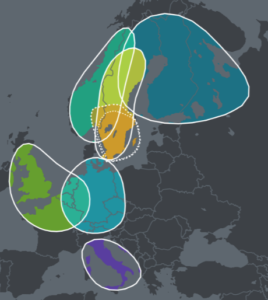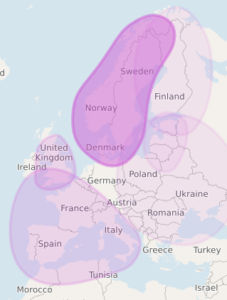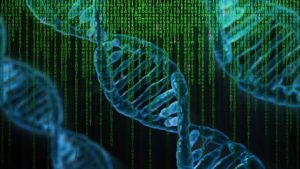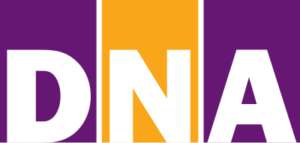Comparing the offerings of the five big DNA testing companies
 4
4Jan
DNA testing and analysis has moved from strictly scientific researchers, to crime fighting, to paternity forensics, to the savviest genealogists, and now to mass marketing to everyone. Its diverse scientific applications can now provide value to consumers with many different interests. These testing kits are sold by different DNA testing companies. Some companies offer only an ethnicity breakdown, or offer lifestyle choice suggestions based on your DNA, such as what foods you should eat. The following comparison will focus on products of the five companies that are best known for direct sales to consumers who are interested in what their DNA can tell them about their genealogy: 23andMe, AncestryDNA, Family Tree DNA, LivingDNA/Findmypast, and MyHeritage.

What sets these tests apart from other DNA tests is that they offer genetic cousin matching. This feature shows you, based on the amount of shared DNA, how closely you are related to others who have tested at the same company. Be warned that many of the other start-ups or smaller companies claiming to do an ancestry DNA test often only give you a haplogroup and perhaps a pie chart of your ancestral breakdown (a certain percentage Europe, Asia, African, or American). This is of interest, but of much less value than the matching feature. A future article will highlight DNA inheritance and the power of matching. Those companies listed above are frequently recommended by genealogists. Each of them is well regarded in the genealogical community, and is a long-standing provider of genealogically useful services.
Family Tree DNA was founded in 1999, with their first offerings including Y-chromosome DNA (Y-DNA) and mitochondrialDNA (mtDNA) testing. This is the only company of the five that offers cousin matching for these important types of tests. These tests are explained or will be explained in other blogs. Their unique additional test offerings, dedicated leadership, and being under the umbrella of their parent organization Gene by Gene--specializing in many other types of DNA testing--has allowed them to maintain a strong position in the marketplace all these years, even without the level of marketing investment of the other four firms. Many genealogists feel that any serious researcher should do their DNA testing with this firm, and praise their analysis tools such as a chromosome browser (a tool that one of the most popular companies--AncestryDNA--is still missing).

Founded in 2006, 23andMe was one of the first companies among these to offer an ancestry testing service. 23andMe is in part known for their backing from Alphabet, the owner of Google. Their greatest distinction are the health reports they offer, which suggest what genetic propensities the test taker possesses. Often, individual features of each company have been reproduced, at least in part, as free tools available elsewhere. In the case of health reports, a free health analysis of DNA has recently become available from Promethease. Of course, customers should carefully consider whether to use third party tools or whether to upload their DNA to other websites. One silly but popular report that 23andMe offers is the percentage of a person's Neanderthal ancestry. Such insignificant, but fun features are found with various tests. In addition to the standard matching and ethnicity estimates, 23andMe also tells customers their Y-DNA and mtDNA haplogroups (females only receive mtDNA so they only get an mtDNA haplogroup). The most significant value of testing with 23andMe is that there are many people who did it just for their ethnicity or their health reports, but have continued to allow their results appear for their cousin matches as well. Therefore, most genealogists will recommend that a client who is serious about solving a genealogical problem have their DNA tested with all five major companies. It is impossible to tell without testing if the relative who can solve your problem has tested with one of the other companies. 23andMe and AncestryDNA are probably the two most popular among the general population in the United States, so you are most likely to find your best cousin matches with these two tests. There are exceptions to be discussed concerning some of the other tests.

AncestryDNA by Ancestry.com as it now exists was launched in 2012. Previously they offered Y-DNA and mtDNA testing, although they were never as good as the same tests from Family Tree DNA. In 2014, Ancestry.com stopped offering those tests, seeing that a new type of general ancestry DNA test offered more value. (Bear in mind that Y-DNA and mtDNA tests still offer much genealogical value, but from that time forward genealogists would rely on Family Tree DNA for those offerings.) Due in part to their major investments in marketing, Ancestry.com has rapidly become the company with the most customers tested: now approximately fourteen million persons. Of all the features and simplicity they offer, the size of their customer base is the most valuable of all. With the most customers, anyone who takes a DNA test is statistically more likely to find matching relatives. As mentioned in the section on Family Tree DNA, Ancestry.com is known by genealogical professionals for their lack of a chromosome browser tool. Therefore, many professionals like to copy their raw DNA data file out of AncestryDNA and import that file into other DNA analysis products, such as GEDmatch (which is not discussed in this article). AncestryDNA is investing a great deal into their DNA product and has added several features in recent years, with likely many more advancements to come. Their "Genetic Communities" feature broke new ground on the level of detail offered with ethnicity estimates. Now, instead of telling the customer of Mexican ancestry that their DNA is simply broadly Native American and Iberian Peninsula, the test can pinpoint a specific Mexican state or region from which their ancestors come. For those with European ancestry, whose ancestors later settled in the United States, this feature can now tell customers that they have ancestors who settled in the northeastern United States. In time, the ethnicity and ancestral location estimates are likely to become even more detailed. AncestryDNA also has other heavily marketed features that should be viewed with some caution. For example, their DNA Circles feature attempts to show customers when multiple test takers share an ancestor. It helps if most of them have uploaded a tree. This makes it possible for customers who have not uploaded a tree to learn of possible genetic ancestors that they may have never heard of before. Often this estimate is correct, but it is also often incorrect. This problem is similar to the problem of the shaky leaf hints in Ancestry’s Member Trees. The inexperienced user will often simply believe any record hint or genetic hint that is shown, when the reality is that these are often incorrect. As with any of the companies, the data should be considered with care, and an attempt made to get some genetic genealogy education in order to avoid coming to incorrect conclusions.

MyHeritage was founded in Israel in 2003, and became the largest commercial genealogical website for European customers. It was not as widely known in America until more recent years when their marketing in the United States increased, and offices were opened in Utah and California. MyHeritage DNA was launched in 2016 after testing the waters with their earlier partnership with Family Tree DNA. MyHeritage's strong presence in Europe has rapidly placed them as the most successful DNA company in that region. For this reason, anyone hoping to find a DNA cousin match who lives in Europe will want to include MyHeritage among the companies with whom they test. MyHeritage is also committed to technological improvement, releasing a steady stream of press releases about new features on their website. They offer a chromosome browser and many other useful tools. One of the greatest features is the ability to upload results from any of the other DNA companies listed. Family Tree DNA and Living DNA also allow uploading your DNA results from a different company. Unfortunately, 23andMe and AncestryDNA do not allow this. Therefore, those wishing to benefit from potential matches and features of all databases will need to purchase both AncestryDNA and 23andMe, then upload their file from one of those into the other three websites. The policy regarding uploads tends to change over time. Various features are often included for free, with a fee to upgrade to access other features. Sometimes there is a fee to upload the file itself, but this will be less than buying a new kit.

LivingDNA started in 2004 as DNA Worldwide, but had little impact in the genealogical community until their founding again in 2016 as LivingDNA. They energetically pursued marketing their services and paid attention to collaboration opportunities. Some leaders in the genealogical community took their test within the first year and shared positive reviews of the product. The positive reviews generally centered around LivingDNA offering the best test for United Kingdom ethnicity estimates. With a high level of accuracy, their test can indicate not only that the customer has UK ancestry, but the precise county in England a percentage of ancestry comes from. Unfortunately, at the time of this article, LivingDNA's ethnicity estimates are actually below average to poor in other regions outside the United Kingdom. Also, their promised matching service is not yet public. Nevertheless, the wider genealogical community has bought into LivingDNA's services regardless of this essential missing feature. In 2018, LivingDNA announced a partnership with Findmypast to sell the testing kit under shared branding. Since 2003, Findmypast has been an online genealogy behemoth specializing in providing online access to United Kingdom and Ireland source documents. With Findmypast's backing of LivingDNA, the genealogical community's hope was restored. It had not necessarily faded, but public trust was at risk due to the delay in offering the promised matching service.

In summary, there is genealogical value to having DNA in all five of these databases. The greatest value provided is the ability to match DNA with other customers. Certain DNA companies are more likely to attract certain customers based on their marketing or location. Informed decisions can be made based on those likelihoods, such as participating in the MyHeritage DNA database for those who desire to find European matches. There are many small feature differences from one genetic testing firm to another. These smaller features change all the time. Many of the shortcomings of a single test can be overcome at least in part with the use of third-party tools or websites, or by uploading to more than one of the big five firms. Getting some genetic genealogy education is helpful, and in some situations, it may be advisable to hire a professional to get the most out of the results. Please inquire today with Price Genealogy about a possible DNA analysis project.
Michael
